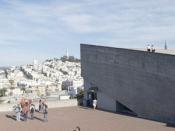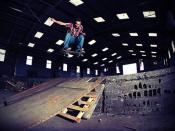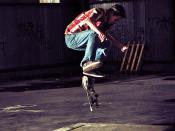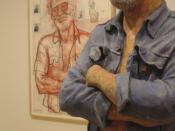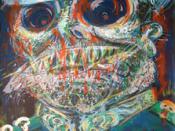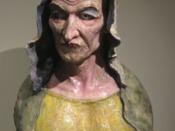Funk art is an art movement that was inspired by popular culture and used random mixes of materials and techniques. The name ÃÂFunk artÃÂ comes from the musical term ÃÂfunkyÃÂ meaning passionate, sensuous, and quirky. Funk art was mostly popular in the United States during the 1960s and 1970s. Artitsts that had done funk art focused on doing their work with humor, confrontation, bawdyness and autobiographical references. They thrived to reintroduce social responsibility into contemporary art.
One funk artist is Manuel Neri who was born on April 12, 1930 in Sanger, California. Manuel attended the San Francisco City College in 1950. He initially wanted to be an electrical engineer, but then he had gone to a ceramic class, and from that point on he realized that he truly had the desire to become an artist. He then left the San Francisco College and went to California College of Arts and Crafts He later also attended the California School of Fine Arts (now the San Francisco Art Institute).
Richard Diebenkorn and Elmer Bischoff had taught him in the past and because of them being his teachers he had taken an interest in abstract expressionism. He then turned towards figurative art.
He was an active member of the artist-run cooperative join gallery, the Six Gallery, in the later 1950s. With him were Joan Brown, Bruce Conner, and Jay DeFeo. Then 9 years later he then became a member of Bruce Conner's Rat Bastard Protective Association. From 1959-1999 he, himself, had become a teacher teaching sculpture and ceramics at the California School of Fine Arts. He was also on the faculty of the University of California, Davis from 1965-1999.
Neri married a women named Joan, who was a Bay Area Figurative. He had two children one name Noel Neri, and the other Ruby Neri, and both are artists. Ruby Neri was known for her graffiti (called ÃÂReminisceÃÂ)and also as part of the first generation of Mission School artists. Neri at this time lives in a home that had once been a church in Benicia, California.
Neri has created many paintings, drawings, and prints, but heÃÂs most famous for his life-size sculptures. His sculptures were so incredible because although they were so clearly figurative in nature, they were abstracted figures rather than realist representations. He usually made the sculptures out of plaster, but also sometimes used marble or bronze.
Another funk artist was Robert Arneson who was born in the year 1930 Benicia, California. He attended Benicia High School, and for most of his youth was a cartoonist for a local paper. He had learnt about art in Oakland, California and had gone to collect his MFA in 1958.
Beginning in the 1960s, he and other artists decided to start something new and different. They had thrown away the traditional manufacture of functional items and instead used objects to make confrontational statements. This new association was called ÃÂFunk ArtÃÂ. Arneson is known to be the ÃÂfather of the ceramic Funk MovementÃÂ.
He had done both ceramic sculptures and drawings using common objects. In his own pieces he had appeared in a numerous amount of them being a chef, a man picking his nose, or a jean jacketed hipster in sunglasses. The last of his works were the Eggheads, which had resembled his as well. In the year 1994 they were put on campus at UC Davis . Arneson had many controversial pieces that still to this day serve as a source of discussion and interest on the campus.
One of ArnesonÃÂs many debatable works was a bust of George Moscone, the mayor of San Francisco who was assassinated in 1978. The controversial part was the inscribing on the pedestal which represented events that had occurred in MosconeÃÂs life including his assassination. It said "Bang Bang Bang Bang" and "Harvey Milk Too!" on the front of the pedestal. Arneson then died in 1992 from cancer.
Bibliography-http://en.wikipedia.org/wiki/Manuel_Neri-http://en.wikipedia.org/wiki/Robert_Arneson-http://en.wikipedia.org/wiki/Funk_art
